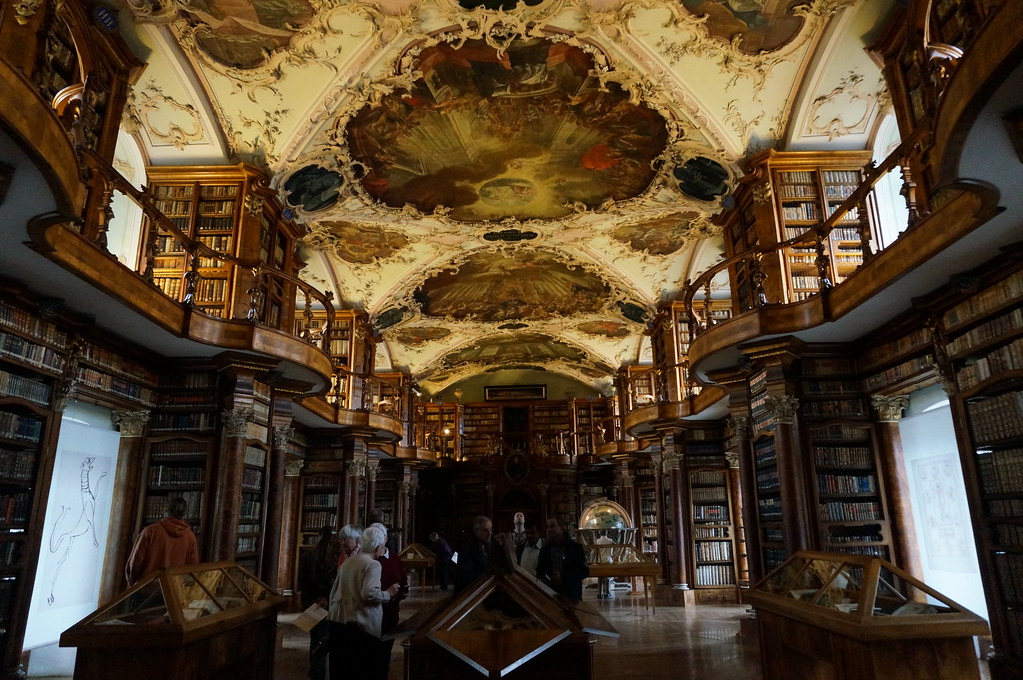 |
| Time for a magical train trip! |
Even though I live in Geneva, I was not officially registered as a resident (apparently, HR never turned in that paperwork), but luckily I have great coworkers who were able to reserve a ticket for me for Monday, April 28th. Since I only had 24 hours and had to be on my last train before midnight to avoid buying additional tickets, I planned out an intense route for the day. My plan was to leave Geneva early, head to St. Gallen (for the Abbey Library and the old town), go from St. Gallen to Sargans to then cross the Swiss border into Liechtenstein and bus to Vaduz (the capital), go back to Sargans from Vaduz, head to Konstanz in Germany across the northern Swiss border, then from Konstanz back to Geneva, all using only public transportation and my 40 CHF pass. Ambitious, I know.
 |
| BUT I DID IT! |
 |
| BOOM |
But I did it, and so I am able to document the trip in this blog post. This was my entire route and distance traveled for the day, beginning at 5:30am and getting back to Geneva 12:30am the following day (Tuesday, April 29th, 2014).
First stop: St. Gallen. St. Gallen is Switzerland's largest eastern city with a beautiful Altstadt (old town) and known for centuries as both an intellectual center and the source of some of the world's finest needlework (including the embroidery work on Michelle Obama's gown at Barack Obama's 2008 inauguration ceremony).
The city is named after the Irish monk, Saint Gallus, who came to the region in 612 AD to live in a hermit's cell in the Steinach Valley. In 719 AD, an abbey was founded on the site where Saint Gallus died. The abbey became a major cultural focus in medieval Europe, especially when the abbey built a library of awesome proportions. It was this library that I came to St. Gallen to see.
 |
| This is the ceiling in the Library's baroque reading room. |
The library's baroque reading room itself is incredible. The wide angle lens used for every picture that you see of the library makes the room appear bigger than it really is, but no matter the size of the room, the frescos on the ceiling and the rows of ancient books across the hardwood floors and beautiful wooden columns are amazing. It really felt like stepping into the library from Beauty and the Beast.
This is the library in St. Gallen, in real life:
In addition to the globe and the mummy, the library also had a really interesting display about old forms of paper, books, and illuminated manuscripts. Some of the old illuminated manuscripts copied by the monks who lived in the abbey even had book curses on them. The monks would write curses into the beginning and ending pages of the books they copied. Supposedly, the curses would protect the books from being stolen by cursing all those who harmed the books or took them from their rightful owners. The display cases also had old paper from Ancient China and papyrus paper from Ancient Egypt, along with old scrolls of parchment sewn together.
There were also old "notebooks" used in the Middle Ages that I found ingenious. They were made of little wooden tablets that were hollowed out to have wax placed inside them. The wax was written on using a metal stylus. The writing end of the stylus was pointed while the opposite end had an edge to smooth out the wax so that it could be reused. These wax-and-wood tablets were then bound together like a three ring binder so that they formed a kind of mini medieval notebook. Pretty cool stuff.
 |
| Wax and Wood Notebook from Medieval times with a writing & smoothing stylus |
On to the next stop: Liechtenstein. This whole time that I've been in Switzerland, Liechtenstein has been calling my name. Well, right back at 'cha, Liechtenstein.
I mean, seriously, who wouldn't want to see what such a teeny tiny country is actually like (even if it's pretty similar to Switzerland)? From Sargans, I was able to hop a bus into Vaduz, Liechtenstein's capital, for a roundtrip ticket of 12 CHF. Also, just to tell you how much this trip was worth it, the Liechtenstein Tourism Office has a booklet with facts all about Liechtenstein entitled, "Liechtenstein: Experience Greatness - Princely Moments." Indeed.
 |
| House on the hilltop next to Vaduz Castle |
However, Liechtenstein is apparently known for its stamps, and the Postmuseum was open to visit for free. It is just a small museum comprising only one floor in a building next to the tourism office, but it has an impressive collection of stamps. There is also a video that describes the whole stamp-making process and how the process has evolved over the years.
There is also the walk up the hillside to the Vaduz Castle. The prince and his family live in the castle so you cannot enter it, but you can walk right up to it and alongside of it, with a great view of Vaduz in the valley below.

Along the way up to the castle, there are signposts with pieces of history all about Liechtenstein. Because it seems like such a unique thing that Liechtenstein is still its own independent country, I thought I should include the facts here too.
Vaduz is the capital of the country with 5,000 inhabitants. It is also the residence of the Princely House, the Seat of the Government.
The Principality of Liechtenstein is a constitutional hereditary monarchy upon democratic and parliamentary basis (1921 constitution). The power of the state is vested in the prince and the people, and the prince is the head of state. Laws come into force only on receiving the assent of the monarch. State administration is carried out by the government. There is a complete system of courts of justice.
History since the foundation of the Principality:
- 1699: Prince Johann Adam Andreas of Liechtenstein purchased the Lordship of Schellenberg
- 1712: Andreas also purchased the County of Vaduz
- 1719: Elevation of both territories to become the Imperial Principality of Liechtenstein, with immediate status, by Emperor Karl VI
- 1806: Liechtenstein becomes a member of the Confederation of the Rhine, no longer part of the Empire
- 1815 to 1866: Membership of the German Confederation
- 1852 to 1919: Customs Treaty with Austria
- 1868: Abolition of the Liechtenstein Army
- 1924: Customs Treaty with Switzerland
- 1978: Member of the European Council
- 1990: Joins the United Nations as its 160th member
- 1991: Member of the EFTA
- 1995: Joins the European Economic Area (EWR) and the World Trade Organization (WTO)
Liechtenstein's Economic Activity: 44.8% is Industry and Industrial Trade; 40,3% is Commerce and Miscellaneous Services; 13.6% is Financial Services; and 1.3% is Agriculture and Forestry.
In the 4th century AD, conveyance of the Christian religion by the Roman army of occupation of the area that is to become Liechtenstein. Around 500 AD, proclamation of the Roman Catholic faith by Bishop Lucius, and Liechtenstein becomes part of the diocese of Chur (in Switzerland). Country patron is Saint Lucius. The Roman Catholic church is the national church in accordance with the constitution (1921). In 1997 the elevation to the rank of Archbishopric of Vaduz by Pope John Paul II.
The family of the Lords of Liechtenstein is first recorded in the first half of the 12th century, when the knight Hugo of Liechtenstein is mentioned. The original family seat was the Modling Castle, south of Vienna. Many members of the House of Liechtenstein serve the emperor as diplomats and generals. In 1608, Karl I of Liechtenstein was elevated to the hereditary rank of prince. The first ruling prince of Liechtenstein was Johann Adam Andreas, who died in 1712. Prince Hans-Adam II is the 13th reigning prince of Liechtenstein. Hans-Adam II was born on February 14th, 1945, with his accession as reigning prince on November 13th, 1989. On July 30th, 1967, he married Countess Marie Kinsky of Wchinitz and Tettau. Hans-Adam II has four children: Prince Alois, born 1968 (take-over of the government business in 2004 as representative of the sovereign prince); Prince Maximilian, born 1969; Prince Constantin, born 1972; and Princess Tatjana, born 1973.
Vaduz castle was first mentioned in documents in 1322. The tower dates from the 12th century. It was partially destroyed in the Swabian War of 1499. Two round towers were added in the 16th century. Further extensions were completed under the Counts of Hohenems in the 17th century. It served as the residence of the prince's bailiff for part of the 18th century, then as a prison. Buildings gradually fell into a state of disrepair. The castle was used as barracks for the Liechtenstein army, then as a tavern, until 1896. The castle underwent extensive renovation under Prince Johann II between 1905 and 1912. The castle contains 130 rooms, and since 1938, has been the permanent residence of the ruling princes and closed to the public.
The view from the hilltop where the castle sits was beautiful. The total size of the country though is something like 62 square miles with a population of 36,000 people. Smaller than Michigan State University's campus and student body, and smaller than the University of Michigan's student population.
 |
| Vaduz Castle |
Konstanz is located on the Bodensee (see means "lake" in German) on the Swiss-German border. The city was first inhabited during the Stone Age and is famous for its harbor, protected by the Imperia. The statue rotates 360 degrees every four minutes and commemorates the Council of Constance that took place in the city between 1414 and 1418. The city also has a beautiful Old Town area where there are remnants of its medieval city wall and is famous for its university (more things too, according to Trip Advisor). And a fun fact: Konstanz is the birthplace of Count Ferdinand von Zeppelin, the inventor of the Zeppelin airships. All in all, I was in Konstanz long enough to see the harbor and the Imperia, but since it was raining, there was not a good view of the lake and because of the train schedules, I did not have too much time to make the walk from the train station into the Old Town.
The trip back to Geneva from Konstanz was the trickiest part of this whole adventure. I had to be on my last train to Geneva before midnight to still make my day pass count and I also had to arrive in Geneva before 1:00am when the trams would cut off for the night and would leave me stranded at Gare Cornavin. Luckily, I had stopped at the SBB/CFF offices along the way to have them print out timetables for me. I was able to use these printouts, my knowledge of Swiss trains, and the phone-a-friend lifeline to verify my alternative route back to Geneva from on the train without internet.
Konstanz
|
Dep. 19:21 (April 28th, 2014)
|
Weinfelden
|
Arr. 19:54
|
Weinfelden
|
Dep. 19:59
|
Bern
|
Arr. 21:58
|
Bern
|
Dep. 22:04
|
Lausanne
|
Arr. 23:15
|
Lausanne
|
Dep. 23:21
|
Geneva
|
Arr. 00:05 (April 29th, 2014)
|
All in all, the trip was great and I was able to see three countries in less than 24 hours, all for 62 CHF. The abbey library in St. Gallen was magnificent and Liechtenstein was just about as randomly awesome as I had hoped. Maybe a bit longer in some other parts of Germany (with better weather) next time, but definitely a good trip in my last week in Geneva.
Next stop, Rome!



 11:30 PM
11:30 PM
 J-Mad
J-Mad


















 Posted in:
Posted in: 
0 comments:
Post a Comment